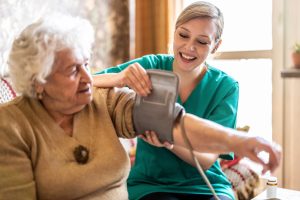High blood pressure basics: Tips on how to help control it and when to follow-up
December 5, 2022High blood pressure, also known as hypertension, is extremely common. Nearly half of adults in the U.S. have it, however only 1 in 4 have their condition under control. If left untreated, hypertension can contribute to cardiovascular disease and medical emergencies ranging from heart attack to stroke or kidney disease.
If you have had a blood pressure reading that is over the normal range, it is important to have follow-up checks. Your doctor can help you manage your blood pressure and find the right way to control it.
What do your numbers mean?
Your blood pressure reading is made up of two numbers. The top number measures systolic blood pressure, which indicates how much pressure your blood is exerting against your artery walls when the heart beats.
The bottom number measures diastolic blood pressure, which indicates how much pressure your blood is exerting against your artery walls while the heart is resting between beats.
Sources may differ slightly, but generally a normal blood pressure for most adults is when your systolic number is less than 120 and your diastolic number is less than 80 according to the American Heart Association. However, this goal can vary depending on age and other medical conditions, so it is best to talk to your doctor about your specific blood pressure goal.
If you have had a blood pressure reading that is over 140/90, it is important to have follow-up checks with your doctor. They can help you manage your blood pressure and find the right way to control it.

What are some ways I can help to lower my blood pressure?
A combination of healthy lifestyle changes can help to lower blood pressure. Examples include:
- Exercise (aerobic) at least 30 minutes most days of the week
It doesn't have to be 30 minutes at once, you can break it up into 10-or even 5-minute chunks of time. Blue Cross offers SilverSneakers®, a health and fitness program designed for adults 65+ and included with qualifying Medicare health plans. Members get access to fitness centers, in-person exercise classes for all abilities, and on-demand videos with both fitness and nutrition tips. - Maintain a healthy weight
- Know what your healthy weight is, and keep it as a long term goal.
- Eat more healthy foods
- Follow the Dietary Approaches to Stop Hypertension (DASH) diet, which focuses on eating vegetables, fruits, and whole grains, while limiting foods that are high in sugar and saturated fats.
- Limit salt/sodium intake to 2300 milligrams per day. Checking the sodium level on nutrition labels at the grocery store before you buy and looking up nutrition levels on restaurant websites before you go is a good way to help make healthy choices.
- Limit your alcohol intake
- Two drinks daily for men and one drink daily for women. One drink = 12 oz of beer, 5 oz of wine, 1.5 oz of 80-proof liquor.
- Practice good sleep habits
- Find ways to manage, reduce and avoid stress
- Avoid smoking or quit smoking
How do I take my blood pressure at home?
Checking your blood pressure regularly at home is a great way for you and your doctor to know if your treatment plan is working for you. Digital blood pressure cuffs approved for home use are available for purchase at your local pharmacy or by using your Over the Counter (OTC) benefit. Tips for taking your blood pressure at home include:
- Allow yourself time to prepare
- Thirty minutes before taking a reading avoid smoking, caffeine, or exercise. The five minutes prior to taking a reading should be quiet rest/relaxation.
- Sit properly
- With your back against a sturdy, flat surface, make sure your feet are placed flat on the ground, with legs uncrossed.
- The arm in which the blood pressure cuff will be placed should be rested on a flat surface (like a table).
- Remain still during the blood pressure reading.
- Use the right size arm cuff
- Make sure the blood pressure cuff is the right size for your arm. A cuff that is too large or too small can give an inaccurate blood pressure reading.
- Take your blood pressure(s) at the same time each day
- If taking more than one blood pressure reading, wait at least one minute between readings.
- Keep a written log (or use an app) to track all of your blood pressure readings.
- Share your blood pressure readings with your doctor at least once a year
- Even if your readings are within normal range. This helps your doctor to know if your treatment plan is working.
How do I know if medication is right for me?
If your blood pressure is over the normal range, there are many things you can do to help manage it. Blue Cross and Blue Shield of Minnesota recommends working with your doctor to see if medication is right for you. If your doctor decides medication is needed to help treat your high blood pressure, it is very important you take the medication(s) as instructed. There are several different options, so if you feel like you have side effects, there are most likely others you can try. If you have questions about your medication(s) please reach out to your doctor. You can also discuss your medications with your local pharmacist or the pharmacist at your clinic (if available).
Remember, often times there are no signs or symptoms of high blood pressure, so even though you may not feel any differently or when you take your medicine, it is still working. It is important to take your medication every day as prescribed.
Additional pharmacy services and plan benefits
Some Blue Cross plans have additional benefits available to help with chronic conditions such as high blood pressure. Here are a few Blue Cross programs and benefits to consider:
- Consider talking to a pharmacist about your medication
Some members, depending on your Blue Cross plan, may be able to talk with a Blue Cross pharmacist to talk about medications at no additional cost. Call 1-866-873-5941 9 a.m. to 5 p.m. Central Time, Monday through Friday or visit bluecrossmn.com/mtm. - Consider mail-order prescription options
If transportation is a challenge or you prefer home delivery, you may be able to have your prescriptions mailed to you through a mail-order prescription program. Visit myprime.com to learn more about your mail-order pharmacy options or to find an in-network pharmacy near you.  Purchase a blood pressure cuff with OTC benefits
Purchase a blood pressure cuff with OTC benefits
Some members, depending on your Blue Cross Medicare plan, can use the Over the Counter (OTC) benefit to purchase a digital blood pressure cuff for home use. Members can use their quarterly allowances through select CVS retail locations, over the phone at 1-888-628-2770, 8 a.m. to 10 p.m., Monday through Friday or online at cvs.com/otchs/bcbsmn.


I do check mine daily. I bought an arm one recently and things have been goof for some time.